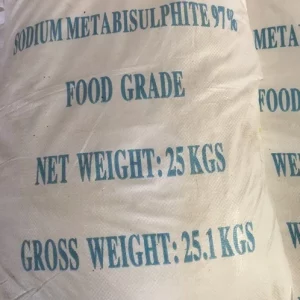
Understanding Sodium Metabisulfite Food Grade: Applications, Benefits, and Safety
Introduction: Sodium metabisulfite food grade is a versatile and widely used food additive, recognized for its various applications in the food industry. In this comprehensive article, we will explore the characteristics, uses, benefits, and safety considerations associated with sodium meta bisulfite in the context of food-grade applications.
What is Sodium Metabisulfite?
Sodium metabisulfite is a white, crystalline powder with the chemical formula Na2S2O5. It is a sodium salt of meta bisulfite, a compound containing sulfur, oxygen, and sodium. In the food industry, it is valued for its antioxidant and antimicrobial properties, making it a popular choice for food preservation and processing.
Applications in the Food Industry:
1. Antioxidant Agent:
Sodium metabisulfite acts as a powerful antioxidant, effectively preventing the oxidation of food products. Oxidation can lead to the degradation of color, flavor, and nutritional content in various foods. By inhibiting oxidative reactions, sodium metabisulfite helps extend the shelf life of products.
2. Preservative:
As a food preservative, SMBS plays a crucial role in inhibiting the growth of microorganisms such as bacteria and fungi. This property is particularly beneficial in preserving the freshness of fruits, vegetables, and certain beverages.
3. Dough Conditioner:
In baking applications, sodium metabisulfite functions as a dough conditioner. It helps improve the texture and quality of baked goods by reducing the dough’s elasticity, making it easier to handle during processing.
4. Bleaching Agent:
Sodium metabi sulfite is utilized as a bleaching agent in certain food products. It can effectively lighten the color of certain fruits, vegetables, and starches, enhancing their visual appeal.
Benefits of Sodium Metabisulfite Food Grade:
1. Shelf Life Extension:
One of the primary advantages of sodium meta bi-sulfite is its ability to extend the shelf life of various food products. By preventing oxidation and microbial growth, it helps maintain the quality and freshness of foods over an extended period.
2. Color Retention:
In the food industry, maintaining the natural color of products is crucial for consumer acceptance. Sodium metabisulfite’s bleaching properties contribute to color retention in fruits, vegetables, and other food items.
3. Improved Dough Handling:
In baking, sodium metabisulfite serves as a dough conditioner, enhancing the handling characteristics of the dough. This is particularly valuable in large-scale bakery operations where efficient processing is essential.
Safety Considerations:
While sodium metabisulfite is generally recognized as safe (GRAS) by regulatory authorities when used in accordance with good manufacturing practices, certain individuals may be sensitive or allergic to sulfites. It is essential for food manufacturers to label products containing sodium meta bi-sulfite and adhere to regulatory guidelines regarding its usage.
Packaging Sodium Metabisulfite Food Grade:
Packaging is done in 25 kg or 1000kg pp bags wrapped with plastic on pallets.
Conclusion:
Sodium metabisulfite food grade is a valuable and versatile additive in the food industry, contributing to the preservation, quality, and appearance of various food products. Its antioxidant and antimicrobial properties make it a reliable choice for extending shelf life and ensuring the overall integrity of food items. As with any food additive, responsible usage and compliance with safety regulations are paramount to delivering high-quality, safe products to consume
